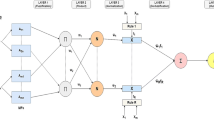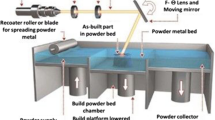Abstract
In this study, by using the double-sided hydroforming process (DSHP), scientific studies have been conducted to reach the highest formability possible with today’s technology in deep drawing at room temperature and to produce difficult-to-shape parts. For the first time, the type-2 fuzzy logic controller (T2FLC) working with adaptive finite element analysis (aFEA) was applied to the DSHP, with the expectation that it would be a satisfactory solution to problems such as wrinkling, especially in the production of parts with different cross sections in the direction of the axis. In the literature, no study was found in which adaptive finite element analysis (aFEA) integrated with fuzzy logic control algorithms and genetic algorithm was applied to the DSHP to obtain the optimum back pressure profile. T2FLC was developed for the conical workpiece, and the variables used in the cylindrical workpiece were used first. DSHP is modeled with finite element method, and fuzzy logic algorithms have been developed to provide adaptive control in analyses. Using the aFEA-FLC optimum loading profiles also internal pressures and blank holder force loading profiles were determined. DSHP experiments were performed by the optimum loading profiles, and manufactured part geometry was compared with the part manufactured by non-applied back pressure in the sheet hydroforming process. By using the loading profiles obtained sheet metal parts have been successfully shaped numerically and experimentally without wrinkling or any other damage. It has been observed that as soon as the back pressure is applied, the wrinkling disappears, and the parts can be formed completely. It was concluded that DSHP is more effective than other hydroforming methods in terms of preventing wrinkling in axisymmetric parts with variable cross section.





















Similar content being viewed by others
Availability of data and material
Not applicable.
Code availability
Not applicable.
References
Teng B, Li K, Yuan S (2013) Optimization of loading path in hydroforming T-shape using fuzzy control algorithm. Int J Adv Manuf Technol 69:1079–1086
Jirathearanat S, Hartl C, Altan T (2004) Hydroforming of Y-shapes-product and process design using FEA simulation and experiments. J Mater Process Technol 146(1):124–129
Feng H, Han C (2018) Study on wrinkling behavior in hydroforming of large diameter thin-walled tube through local constraints. Int J Adv Manuf Technol 99:1329–1340
Cui XL, Wang XS, Yuan SJ (2019) Effects of mechanical property parameters on wrinkling behavior of thin-walled tubes in hydroforming process. Int J Adv Manuf Technol 100:729–740
Khandeparkar T, Liewald M (2008) Hydromechanical deep drawing of cups with stepped geometries. J Mater Process Technol 202(1–3):246–254
Cui XL, Wang XS, Yuan SJ (2014) Deformation analysis of double-sided tube hydroforming in square-section die. J Mater Process Technol 214(7):1341–1351
Kao AS, Kuhn HA, Richmond O, Spitzig WA (1990) Tensile fracture and fractographic analysis of 1045 spheroidized steel under hydrostatic pressure. J Mater Res 5(1):83–91
Wu PD, Embury JD, Lloyd DJ, Huang Y, Neale KW (2009) Effects of super-imposed hydrostatic pressure on sheet metal formability. Int J Plast 25(9):1711–1725
Wang ZJ, Song H, Wang Z (2008) Deformation behavior of TC1titanium alloy sheet under double-sided pressure. T Nonferr Metal Soc 18:72–76
Liu W, Chen YZ, Yuan SJ (2016) Mechanism analysis on thickness distribution of aluminum alloy hemispherical shells in double-sided sheet hydroforming. Int J Adv Manuf Technol 89:2011–2020
Feng SL (2011) Drawing of 5A06 aluminum alloy chamfered cup with double side pressure. Master Thesis, Harbin Institute of Technology, Institute of science and technology, Heilongjiang
Choi H, Koc M, Ni J (2007) Determination of optimal loading profiles in warm hydroforming of lightweight materials. J Mater Process Technol 190:230–242
Ozturk E, Turkoz M, Halkaci S, Halkaci M (2014) An application of fuzzy logic control algorithm in hydro mechanical deep drawing process. Appl Mech Mater 686:95–100
Sheng ZQ, Jirathearanat S, Altan T (2004) Adaptive FEM simulation for prediction of variable blank holder force in conical cup drawing. Int J Mach Tools Manuf 44:487–494
Intarakumthornchai T, Jirathearanat S, Juntaratin J (2011) Determination of loading paths in hydromechanical deep drawing process of parabolic cup with FEA based 2-D interval halving and fuzzy logic. METEC, Düsseldorf
Shamsi-Sarband A, Zahedi SA, Bakhshi-Jouybari M, Hossinipour SJ, Banabic D (2012) Optimization of the pressure path in sheet metal hydroforming. Proc Rom Acad Ser A 13:351–359
Leondes CT (1998) Fuzzy logic and expert systems application. Academic Pres, California, USA
Chu B, Kim D, Hon D, Park J, Chung JT, Chung JH, Kim TH (2008) GA-based fuzzy controller design for tunnel ventilation systems. Auto Constr 17:130–136
Alam MS, Tokhi MO (2008) Hybrid fuzzy logic control with genetic optimisation for a single-link flexible manipulator. Eng Appl of Artif Intell 21:858–873
Castillo O, Melin P (2008) Type-2 fuzzy logic: theory and applications. Verlag Berlin Heidelberg Springer
Ustun SV, Demirtas M (2008) Optimal tuning of PI coefficients by using fuzzy-genetic for V/f controlled induction motor. Expert Syst Appl 34:2714–2720
Tınkır M, Dilmeç M, Türköz M, Halkacı HS (2014) Investigation of the effect of hydromechanical deep drawing process parameters on formability of AA5754 sheets metals by using neuro-fuzzy forecasting approach. J Intell Fuzzy Syst 28(2):647–659
Koyama H, Manabe K, Yoshihara S (2003) A database oriented process control design algorithm for improving deep-drawing performance. J Mater Process Tech 138:343–348
Ozturk E, Turkoz M, Halkaci HS, Koc M (2017) Determination of optimal loading profiles in hydromechanical deep drawing process using integrated adaptive finite element analysis and fuzzy control approach. Int J Adv Manuf Technol 88:2443–2459
Kelekçi E (2016) Development of type-2 fuzzy logic editor and control of flexible articulated robot arm. Institute of Science, Kocaeli University
Mendel JM (2001) Uncertain rule-based fuzzy logic systems: introduction and new directions. Prentice-Hall, Upper Saddle River, NJ
Akay SB (2021) Numerical and experimental determination of process parameters in double-sided sheet hydro forming, Graduate School of Natural and Applied Sciences. PhD Thesis, Konya Technical University, Konya, Turkey
Urmamen MK, Ataş G, Dilmeç M, Türköz M, Öztürk O, Halkacı HS (2021) Design, fabrication and performance tests of a double-sided sheet hydroforming test system. Indian J Eng Mater Sci Accepted
Acknowledgements
This work has been extracted from Selahattin Burak Akay’s Ph.D. thesis.
Funding
This article was supported by the Scientific and Technological Research Council of Turkey (TUBITAK) (grant number 217M700).
Author information
Authors and Affiliations
Contributions
SBA: methodology, investigation, experimental and numerical study, review, and editing. HSH: funding acquisition, conceptualization, methodology. EÖ: investigation, experimental study, writing, and editing. OÖ: investigation, experimental study, writing, and editing. GA: investigation, experimental study. MA: investigation, experimental study. MT: methodology, investigation, experimental and numerical study, review, and editing. MD: methodology, investigation, writing—review, and editing.
Corresponding author
Ethics declarations
Ethics approval
Not applicable.
Consent to participate
The Authors accept to participate.
Consent for publication
The Authors agree with publication.
Conflict of interest
The authors declare no competing interests.
Additional information
Publisher's note
Springer Nature remains neutral with regard to jurisdictional claims in published maps and institutional affiliations.
Rights and permissions
About this article
Cite this article
Akay, S.B., Halkacı, H.S., Öztürk, E. et al. Numerical and experimental investigation of the effect of double-sided hydroforming process on wrinkling damage by optimizing loading curves with adaptive control. Int J Adv Manuf Technol 121, 2149–2168 (2022). https://doi.org/10.1007/s00170-022-09467-8
Received:
Accepted:
Published:
Issue Date:
DOI: https://doi.org/10.1007/s00170-022-09467-8




